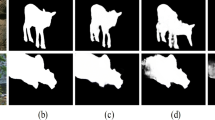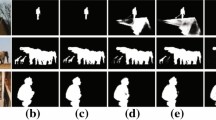Abstract
As the network deepens, the boundary information and small object will be lost, which result in blurred edges and incomplete salient detection. In this paper, we propose a multi-feature aggregated network to solve this problem. First, the edge features are gained through the shallow network. Then, we extract multi-level salient features of the encoder layer by the multi-level features extraction module. In order to make the most of these features, we combine the edge features with the multi-level features. Finally, the fused features are sent to the residual refinement module to obtain the final saliency map. The experimental results show that the proposed method performs better than other six methods on four public datasets.









Similar content being viewed by others
References
Gao, Y., Wang, M., Tao, D., et al.: 3-D object retrieval and recognition with hypergraph analysis. IEEE Trans. Image Process. 21(9), 4290–4303 (2012)
Mahadevan, V., Vasconcelos, N.: Saliency-based discriminant tracking. In: IEEE Conference on Computer Vision and Pattern Recognition, pp. 1007–1013 (2009)
Li, B., Sun, Z., Tang, L., et al.: Two-B-real net: two-branch network for real-time salient object detection. In: Proceedings of the IEEE International Conference on Acoustics, Speech, and Signal Processing, pp. 1662–1666 (2019)
Craye, C., Filliat, D., Goudou, J.F.: Environment exploration for object-based visual saliency learning. In: Proceedings of the IEEE International Conference on Robotics and Automation (ICRA), pp. 2303–2309 (2016)
Long, J., Shelhamer, E., Darrell, T.: Fully convolutional networks for semantic segmentation. In: Proceedings of the IEEE Conference on Computer Vision and Pattern Recognition, pp. 3431–3440 (2015)
Pang, Y., Zhao, X., Zhang, L., et al.: Multi-scale interactive network for salient object detection. In: Proceedings of the Conference on Computer Vision and Pattern Recognition, pp. 9140–9149 (2020)
Zhao, X., Pang, Y., Lu, H., et al.: Suppress and balance: a simple gated network for salient object detection. In: Proceedings of the European conference on Computer Vision, pp. 35–51 (2020)
Tang, L., Li, B.: CLASS: cross-level attention and supervision for salient objects detection. In: Asian Conference on Computer Vision (2020)
Li, B., Sun, Z., Guo, Y.: SuperVAE: Superpixelwise variational autoencoder for salient object detection. In: Proceedings of the AAAI Conference on Artificial Intelligence, pp. 8569–8576 (2019)
Qin, X., Zhang, Z., Huang, C., et al.: U2-Net: Going deeper with nested U-structure for salient object detection. Pattern Recognit. 106, 107404 (2020)
Liu, J., Hou, Q., Cheng, M., et al.: A simple pooling-based design for real-time salient object detection. In: Proceedings of the IEEE Conference on Computer Vision and Pattern Recognition, pp. 3917–3926 (2019)
Qin, X., Zhang, Z., Huang, C., et al.: Basnet: boundary-aware salient object detection. In: Proceedings of the IEEE Conference on Computer Vision and Pattern Recognition, pp. 7479–7489 (2019)
Liu, T., Sun, J., Zheng, N., et al.: Learning to detect a salient object. In: Proceedings of the Conference on Computer Vision and Pattern Recognition, pp. 1–8 (2007)
Shi, J., Yan, Q., Xu, L., et al.: Hierarchical image saliency detection on extended cssd. In: IEEE Transactions on Pattern Analysis and Machine Intelligence, pp. 717–729 (2015)
Zhang, L., Zhang, J., Lin, Z., et al.: Capsal: leveraging captioning to boost semantics for salient object detection. In: Proceedings of the IEEE Conference on Computer Vision and Pattern Recognition, pp. 6024–6033 (2019)
Tang, L., Li, B., Zhong, Y., et al.: Disentangled high quality salient object detection. In: Proceedings of the IEEE International Conference on Computer Vision, pp. 3580–3590 (2021)
Feng, M, Lu, H., Ding, E., et al.: Attentive feedback network for boundary-aware salient object detection. In: Proceedings of the Conference on Computer Vision and Pattern Recognition, pp. 1623–1632 (2019)
Zhang, L., Dai, J., Lu, H., et al.: A bi-directional message passing model for salient object detection. In: Proceedings of the IEEE Conference on Computer Vision and Pattern Recognition, pp. 1741–1750 (2018)
Chen, Z., Xu, Q., Cong, R., et al.: Global context-aware progressive aggregation network for salient object detection. In: Proceedings of the Thirty-Fourth AAAI Conference on Artificial Intelligence, pp. 10599–10606 (2020)
Zhao, T., Wu, X.: Pyramid feature attention network for saliency detection. In: Proceedings of the IEEE Conference on Computer Vision and Pattern Recognition, pp. 3085–3094 (2019)
Zhao, J., Liu, J., Fan, D., et al.: EGNet: edge guidance network for salient object detection. In: Proceedings of the IEEE Conference on Computer Vision and Pattern Recognition, pp. 8779–8788 (2019)
Su, J., Li, J., Zhang, Y., et al.: Selectivity or invariance: boundary-aware salient object detection. In: Proceedings of the IEEE International Conference on Computer Vision, pp. 3799–3808 (2019)
Li, X., Yang, F., Cheng, H., et al.: Contour knowledge transfer for salient object detection. In: Proceedings of the European Conference on Computer Vision, pp. 355–370 (2018)
Li, B., Sun, Z., Tang, L., et al.: Detecting robust co-saliency with recurrent co-attention neural network. In: Proceedings of the International Joint Conference on Artificial Intelligence, pp. 818–825 (2019)
Olaf, R., Philipp, F., Thomas, B.: Unet: convolutional networks for biomedical image segmentation. In: International Conference on Medical Image Computing and Computer-Assisted Intervention, pp. 234–241 (2015)
Woo, S., Park, J., Lee, J., et al.: CBAM: convolutional block attention module. In: Proceedings of the European Conference on Computer Vision (2018)
He, K., Zhang, X., Ren, S., et al.: Deep residual learning for image recognition. In: Proceedings of the IEEE Conference on Computer Vision and Pattern Recognition, pp. 770–778 (2016)
Wang, L., Lu, H., Wang, Y., et al.: Learning to detect salient objects with image-level supervision. In: Proceedings of the IEEE Conference on Computer Vision and Pattern Recognition, pp. 136–145 (2017)
Li, G., Yu, Y.: Visual saliency based on multi-scale deep features. In: Proceedings of the IEEE Conference on Computer Vision and Pattern Recognition, pp. 5455–5463 (2015)
Li, Y., Hou, X., Koch, C., et al.: The secrets of salient object segmentation. In: Proceedings of the IEEE Conference on Computer Vision and Pattern Recognition, pp. 280–287 (2014)
Achanta, R., Hemami, S., Estrada, F., et al.: Frequency tuned salient region detection. In: Proceedings of the IEEE Conference on Computer Vision and Pattern Recognition, pp. 1597–1604 (2009)
Perazzi, F., Krahenbuhl, P., Pritch, Y., et al.: Saliency fifilters: contrast based fifiltering for salient region detection. In: Proceedings of the IEEE Conference on Computer Vision and Pattern Recognition, pp. 733–740 (2012)
Fan, D., Cheng, M., Liu, T., et al.: Structure measure: a new way to evaluate foreground maps. In: Proceedings of the IEEE International Conference on Computer Vision, pp. 4548–4557 (2017)
Xu, Y., Xu, D., Hong, X., et al.: Structured modeling of joint deep feature and prediction refifinement for salient object detection. In: Proceedings of the IEEE International Conference on Computer Vision, pp. 3789–3798 (2019)
Zhang P, Wang D, Lu H, et al.: Amulet: aggregating multi-level convolutional features for salient object detection. In: Proceedings of the IEEE International Conference on Computer Vision, pp. 202–211 (2017)
Zhang, P., Wang, D., Lu, H., et al.:Learning uncertain convolutional features for accurate saliency detection. Proceedings of the IEEE International Conference on Computer Vision, pp.212–221(2017)
Tang, L., Li, B., Wu, Y.: Fast: feature aggregation for detecting salient object in real-time. In: Proceedings of the IEEE International Conference on Acoustics, Speech, and Signal Processing, pp. 1525–1529 (2021)
Acknowledgements
This work is supported in part by National Natural Science Foundation of China (61976237, 61673404, 619220-72), Zhongyuan Qianren Project (ZYQR201810162), the Key Scientific Research Projects in Colleges and Universities of Henan Province (Grant Nos. 19A120014, 20A120013) and Basic research Funds of Zhongyuan University of Technology (K2020QN019).
Author information
Authors and Affiliations
Corresponding author
Additional information
Publisher's Note
Springer Nature remains neutral with regard to jurisdictional claims in published maps and institutional affiliations.
Rights and permissions
About this article
Cite this article
Huang, H., Liu, P., Wang, Y. et al. Multi-feature aggregation network for salient object detection. SIViP 17, 1043–1051 (2023). https://doi.org/10.1007/s11760-022-02310-3
Received:
Revised:
Accepted:
Published:
Issue Date:
DOI: https://doi.org/10.1007/s11760-022-02310-3




